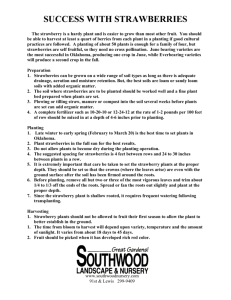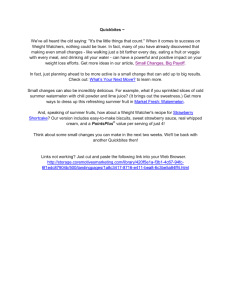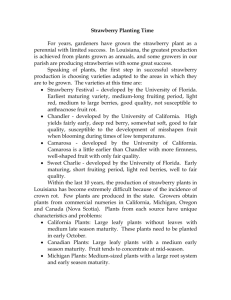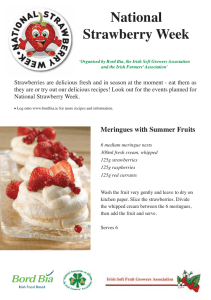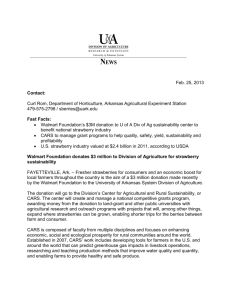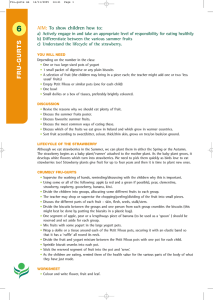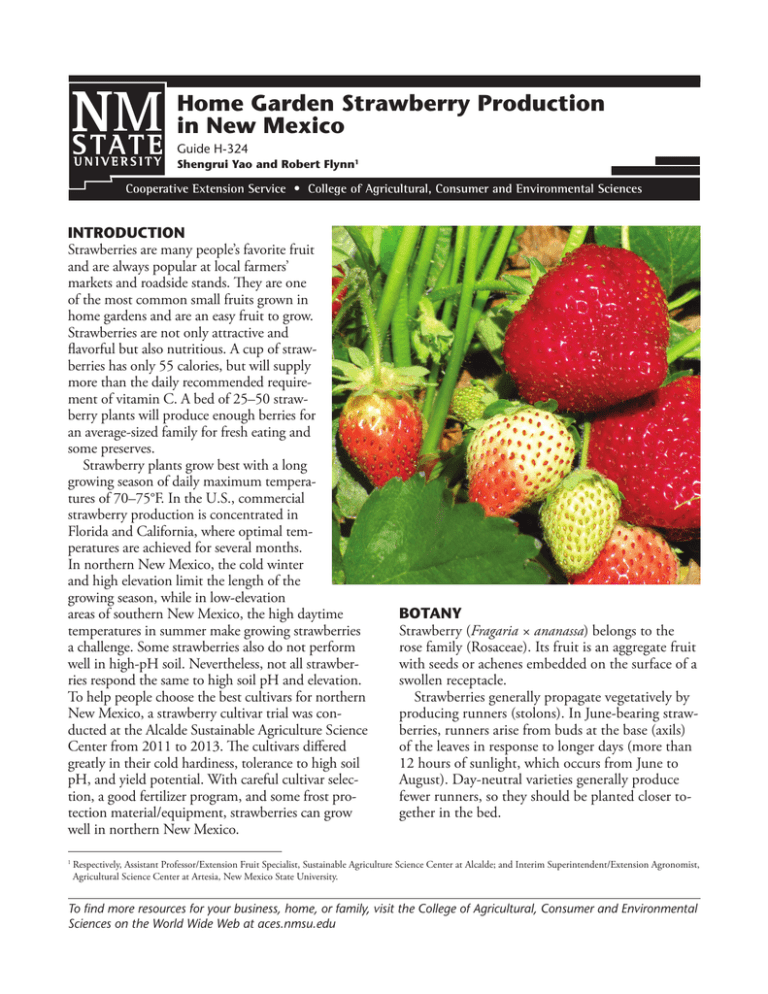
Home Garden Strawberry Production
in New Mexico
Guide H-324
Shengrui Yao and Robert Flynn1
Cooperative Extension Service • College of Agricultural, Consumer and Environmental Sciences
INTRODUCTION
Strawberries are many people’s favorite fruit
and are always popular at local farmers’
markets and roadside stands. They are one
of the most common small fruits grown in
home gardens and are an easy fruit to grow.
Strawberries are not only attractive and
flavorful but also nutritious. A cup of strawberries has only 55 calories, but will supply
more than the daily recommended requirement of vitamin C. A bed of 25–50 strawberry plants will produce enough berries for
an average-sized family for fresh eating and
some preserves.
Strawberry plants grow best with a long
growing season of daily maximum temperatures of 70–75°F. In the U.S., commercial
strawberry production is concentrated in
Florida and California, where optimal temperatures are achieved for several months.
In northern New Mexico, the cold winter
and high elevation limit the length of the
growing season, while in low-elevation
areas of southern New Mexico, the high daytime
temperatures in summer make growing strawberries
a challenge. Some strawberries also do not perform
well in high-pH soil. Nevertheless, not all strawberries respond the same to high soil pH and elevation.
To help people choose the best cultivars for northern
New Mexico, a strawberry cultivar trial was conducted at the Alcalde Sustainable Agriculture Science
Center from 2011 to 2013. The cultivars differed
greatly in their cold hardiness, tolerance to high soil
pH, and yield potential. With careful cultivar selection, a good fertilizer program, and some frost protection material/equipment, strawberries can grow
well in northern New Mexico.
1
BOTANY
Strawberry (Fragaria × ananassa) belongs to the
rose family (Rosaceae). Its fruit is an aggregate fruit
with seeds or achenes embedded on the surface of a
swollen receptacle.
Strawberries generally propagate vegetatively by
producing runners (stolons). In June-bearing strawberries, runners arise from buds at the base (axils)
of the leaves in response to longer days (more than
12 hours of sunlight, which occurs from June to
August). Day-neutral varieties generally produce
fewer runners, so they should be planted closer together in the bed.
Respectively, Assistant Professor/Extension Fruit Specialist, Sustainable Agriculture Science Center at Alcalde; and Interim Superintendent/Extension Agronomist,
Agricultural Science Center at Artesia, New Mexico State University.
To find more resources for your business, home, or family, visit the College of Agricultural, Consumer and Environmental
Sciences on the World Wide Web at aces.nmsu.edu
STRAWBERRY TYPES AND CULTIVARS
There are three types of strawberries: June-bearing,
everbearing, and day-neutral. They differ primarily
in their response to day length, which affects both
berry and runner production.
June-bearing
June-bearers develop flowers in the early spring from
buds initiated the previous fall under short-day conditions (less than 10 hours of light per day). During
the fall (September–November), it is essential that
the plants have a full, well-developed leaf canopy to
produce sufficient energy for flower bud development. June-bearers tend to out-produce other types
of strawberries, but late frosts in the spring can
significantly reduce overall yield. Frost protection is
highly recommended.
A June-bearing strawberry trial with 16 cultivars in
two planting systems (matted-row and black plasticcovered) was conducted at NMSU’s Alcalde Sustainable Agriculture Science Center from 2011–2013.
To evaluate cultivar tolerance to high soil pH, there
was no supplemental iron applied until August of
the planting year. Later, chelate iron was applied to
manage leaf chlorosis. Among the 16 cultivars tested,
Mesabi and Kent were the top two cultivars with the
highest yield (Table 1).
Wendy had the worst winter damage in the plasticcovered perennial system. Allstar, Chandler, and
Darselect were the cultivars most sensitive to the highpH soil in northern New Mexico. Earliglow had fruit
with good flavor, but yields were extremely low during
both harvest seasons. Mesabi plants had iron deficiency symptoms, but they were not as severe as Allstar
and Chandler. Mesabi had good flavor and winter hardiness and was very productive and disease resistant;
it is a good cultivar for northern New Mexico. Kent
had good flavor, was winter hardy, and produced a
good yield. Cabot had big fruit with satisfactory fruit
quality. Jewel is a longtime performer in several other
states with good flavor and reasonable yield, but it is
not very hardy in northern New Mexico. Early cultivars like Earliglow, Annapolis, Wendy, and Brunswick
were more vulnerable to late spring frost. Growers
have a better chance at getting a good crop with midseason cultivars. For late cultivars, they may run into
summer heat stress before they reach their yield potential. Please also refer to www.strawberryplants.org for
detailed cultivar descriptions.
Everbearing
Everbearing strawberries initiate flower buds under
long-day conditions (more than 12 hours of sunlight).
They will generally produce two main crops (spring
and fall), but the total yield is less than a single spring
crop from a June-bearer. Everbearers, however, have
the advantage that if the spring crop is lost to frost,
the fall crop will still produce. Everbearers produce
fewer runners and tend to form multiple crowns. They
should be planted closer together than June-bearers.
Everbearers do not tolerate heat well, so they should
only be grown in the northern part of the state.
Day-neutral
Day-neutral strawberries have the unique ability to
flower and fruit under any day-length conditions.
They will produce fruit from spring through fall, with
several peaks throughout the season. Temperatures
above 70°F, however, will inhibit flower bud formation. Day-neutrals produce fruit and runners simultaneously, although runner production is generally less
than that of June-bearers. A drawback of day-neutral
cultivars is that they often produce smaller berries
than June-bearers.
Day-neutrals and everbearers are often used interchangeably in the industry since the two behave similarly in temperate regions. There have been no recent
cultivar trials for everbearers in New Mexico. However, here are some general recommendations.
Seascape: Large berry with good yields, cold tolerance, and flavor.
Tribute: Medium-large, short cone- to wedgeshaped, bright red berries; pleasant flavor; good dessert
and processing qualities; resistant to red stele root rot.
Tristar: Medium-sized, symmetrical, short conic,
deep red fruit; good dessert and freezing qualities;
more sensitive to high soil pH than Tribute.
Albion, San Andreas, and Evie 2: These are newer
selections with growing popularity in other states; test
before planting in volume.
SITE SELECTION
Strawberry blossoms are susceptible to late spring
frosts. Those early blossoms are primary or secondary flowers and produce the largest berries.
Loss of these flowers will reduce yield. Locating
strawberry beds on elevated areas of the garden
with gentle slopes will allow heavy cold air to
drain away from the bed, helping to reduce frost
Guide H-324 • Page 2
Table 1. Strawberry Yield for 2012 and 2013 of 16 June-bearing Strawberry Cultivars at Alcalde, NM
2012
Cultivar
g/10 ft
2013
lb/acre
g/10 ft
Average
lb/acre
g/10 ft
lb/acre
Mesabi
6187
14840
7731
18544
6959
16693
Kent
4823
11568
6739
16165
5781
13867
Cavendish
6288
15084
3213
7706
4751
11395
Cabot
3143
7538
2497
5990
2820
6765
Jewel
3090
7411
2166
5196
2628
6304
Brunswick
2596
6228
2395
5746
2496
5987
Darselect
2059
4940
2495
5985
2277
5462
Allstar
1821
4368
1950
4677
1886
4523
Honeoye
1460
3502
1856
4453
1659
3978
L’Amour
1956
4691
1248
2994
1602
3843
Chandler
571
1370
2358
5655
1465
3513
Wendy
1019
2444
1619
3883
1319
3164
Clancy
512
1227
1885
4521
1199
2875
Annapolis
1162
2786
1143
2743
1153
2765
Ovation
1142
2738
934
2239
1038
2489
Earliglow
288
690
532
1275
410
983
damage. A northern exposure may help delay
bloom in the spring if late frosts are a problem.
Earlier production can be achieved by selecting
a southern exposure that warms earlier in the
spring, but this will also increase the risk of frost
damage. Plants may have to be covered with a
straw mulch or frost blanket at night to protect
them if frost becomes a problem. Locations next
to a house are often warmer due to heat generated
from the home.
Strawberries prefer full sun, although afternoon
shade or shade cloth to reduce sunlight intensity
may be needed in southern New Mexico. However,
shady locations can cause more vegetative plants
with fewer berries and more disease problems.
Avoid planting strawberries after peppers, tomatoes, potatoes, eggplant, or okra, all of which are
susceptible to Verticillium wilt, which can remain
in the soil and affect strawberries. Strawberry plots
following sod may have to be treated to control
white grub. Sites should also be free of noxious
and perennial weeds.
SOIL PREPARATION
Strawberries grow best in well-drained, sandy loam
soils high in organic matter and fertility. Before
planting, a soil test for pH and nutrient levels is recommended. Soils should be neutral to slightly acidic
(pH 6.5). Plants established on more alkaline soils
(pH 7.5 or greater) tend to exhibit signs of iron deficiency (yellowing between leaf veins, or interveinal
chlorosis, of younger leaves; see Figure 1). In severe
cases, pale leaves become white, turn brown around
the edges, and then die. Strawberry plants are also
highly sensitive to salts in the irrigation water or soil
(salinity). High total salinity causes stunting, marginal leaf scorch, and severe yield reduction. Enough
water should be applied to ensure that salts are
leached below the root zone.
Strawberry cultivars vary in their adaptation to
high soil pH. Among the 16 cultivars tested at Alcalde, Allstar, Chandler, and Darselect were the most
sensitive cultivars and should be avoided if other
choices are available. Wendy was the most tolerant
cultivar to high soil pH; however, its winter hardiness was poor.
Guide H-324 • Page 3
Wendy
Allstar
08/02/2011
10/07/2011
Figure 1. Leaf color of Wendy and Allstar before and two months after iron chelate (FeEDDHA)
application. Iron chelate was applied on August 5 and 15, 2011.
The soil should be prepared before planting by
incorporating organic matter (2–3 inches of garden
compost) into the bed to a depth of at least 8 inches.
Organic matter will improve nutrient availability as
well as the structure and water-holding capacity of
the soil over time. Avoid over-application of some
composts that may be high in salt content.
Soil drainage can be improved by planting on
raised beds (36 inches wide and 3–4 inches high),
which will also warm sooner in the spring than
flat ground but can make the plants vulnerable to
late frosts. However, planting on flat ground may
be preferred where salinity is a problem (electrical
conductivity greater than 1.5 mmhos/cm) and it
is necessary to flood the beds occasionally to move
salts down through the soil profile. If drip or sprinkler irrigation systems are used, salts will be leached
down from the tops of the raised beds.
FERTILIZATION
Before planting, approximately 1.0 lb/100 ft2 of
12-24-12 fertilizer should be incorporated into the
planting bed to a depth of 6–8 inches. The rate will
depend on the results of a soil analysis. Additional
nitrogen may be necessary once new growth begins
in the spring and again 3–4 months later at a rate
of 0.5 lb/100 ft2 of ammonium sulfate (21-0-0)
per application. Scatter the fertilizer evenly across
the bed and work it into the soil. Wash fertilizer
off plant leaves to prevent leaf burn, and irrigate
the bed after application. In following years, spring
fertilizer application and after-harvest application
are recommended with ammonium sulfate or an
alternative with 10-10-10 or 24-8-16 through fertigation or side dressing. Plant-available soil phosphorus, potassium, and other nutrients should be
evaluated before purchasing fertilizers.
Iron chlorosis problems can be corrected with
applications of an iron chelate. Based on the Alcalde trial, the chelated iron product FeEDDHA
could manage iron deficiency efficiently through
irrigation or soil application. Two to three applications per year at 20 g/100 ft can control leaf chlorosis for most cultivars. Apply the product either
when leaf chlorosis appears or as a combination
of one spring and one fall application. Soil or leaf
application is also possible if drip irrigation is not
available. Please follow the product label.
Guide H-324 • Page 4
PLANTING
Bare-root plants should be ordered early (before
spring planting) to ensure that appropriate cultivars
are available. Buy only certified virus-free plants
that have been inspected for pests and bred for disease resistance. Beds should be prepared before your
scheduled planting date.
Planting in the spring after danger of hard
frost ensures greater plant survival because the
weather is cool. Plants should be dormant and
healthy upon arrival. Crowns should be solid with
light-colored roots. If new plants arrive early, they
can be stored at 30–32°F with 85–90% relative
humidity (wrapped in moist packing materials).
Plants can also be “healed in” in the garden for
temporary storage. To heal in the plants, place
them in a shallow trench, cover the roots with soil,
and water them.
Planting depth is critical for strawberries. The
crown (where leaves are attached) should be level
with the surface of the soil. If planted too shallow, the roots will dry out; when planted too deep,
the plants will rot. Firm the soil over the roots and
around the base of the crown so no air pockets form.
Water plants immediately. One pint of fertilizer
starter solution around each plant will help promote
early growth. A starter solution can be made of one
cup of 12-12-12 or 12-24-0 per 10 gallons of water.
soms appear. Allowing blossoms and fruit to form
will reduce the vigor of the new plants. Blossoms
and fruit can be allowed to form the following
spring. A problem with the matted-row system is
that too many plants can form, which can result in
smaller berries and poor yields. Another issue with
this system is weed management, especially the first
year after planting.
The plastic-covered perennial system uses black
woven fabric (weed barrier) to cover the raised
bed. Plants are placed in a single row, or staggered
double rows about 1 foot apart. It can be used for
both June-bearing and everbearing/day-neutral
strawberries. Runners do not root in the plastic
cover system and have to be removed periodically.
There is less weed pressure with this system. Some
tender cultivars tend to have winter damage in
this system since the mother plants have branched
crowns and root themselves higher and higher
each year. Growers should either select hardy cultivars or protect the plants in winter by covering
with straw or tree leaves.
During the first growing season, the flowers are
generally removed in the spring but can be allowed
to set berries in the fall for everbearing/day-neutral
cultivars. They normally fruit well for two harvest
seasons and then decline and need to be removed
or replanted.
PLANTING SYSTEMS
Strawberries can be planted in either a matted-row
system or a plastic-covered perennial system (Figure 2).
The choice of planting system generally depends upon
the type of strawberry and personal preference.
In a matted-row system, plants are generally
spaced around 18 inches apart in rows with 36- to
42-inch centers. Runners are allowed to develop to
fill the empty spaces between plants until the rows
are 12–18 inches wide. The middles between rows
are kept free of plants. In New Mexico, some cultivars tend to produce excessive runners. The study
in Alcalde encountered a crowded bed issue. Runners can root themselves and should be 6–8 inches
apart. If the strawberry bed becomes overcrowded,
pinch the later runners or thin some runners out
manually. A matted-row system is generally used
for June-bearers. During the first growing season,
remove (pinch out) flower stalks before the blos-
MANAGEMENT
Drip irrigation is highly recommended for strawberries in order to save water and ease weed management and fertilizer applications. Sprinklers can
be used for frost protection during blooming time.
If sprinklers are used for routine irrigation, it can
cause disease problems.
Mulches are often used in strawberry production to reduce soil moisture evaporation, reduce
weed growth, prevent mud from splashing on
berries, reduce fruit rots, and protect plants from
winter damage. The choice of mulch depends on
the type of strawberry being grown, growing season characteristics, and management objectives.
Organic mulches are often used with June-bearing strawberries (matted-row system) in warmer
areas of the state to help cool the soil. Clean straw
(free of weed seed) and pine needles tend to keep
berries clean and dry. Do not use lawn clippings,
Guide H-324 • Page 5
Figure 2. A plastic-covered planting system.
which tend to mat and attract pests such as snails,
slugs, and sowbugs (pillbugs or roly-polies). Runners can be easily manipulated to root down
through the mulch.
White plastic (non-translucent) mulches can be
used with everbearing and day-neutral varieties that
form fewer runners and are planted closer together.
White plastic, like organic mulches, tends to cool
the soil in warmer areas of the state.
Black woven plastic fabric can be used in colder
areas of the state. Woven fabrics are preferred because
they allow the soil to “breathe” and water to penetrate. Drip irrigation can be used underneath either
plastic or fabric for optimal irrigation efficiency.
When using plastic or fabric, a hill system planted with everbearing or day-neutral cultivars is preferred because runners are discouraged, but plastic/
fabric could also work for June-bearing cultivars.
Straw mulch can also be used in northern New
Mexico to protect plants from freezing in the
winter. A 3- to 4-inch straw mulch layer should
be applied after frost in early winter and should
not be removed until after new growth (2 inches)
begins in the spring. The straw mulch does not
need to be fully removed; pull some in between
the rows and keep some in place to help keep the
fruit clean.
Strawberries grown in warmer areas of the state
will require some shade on summer afternoons.
This will reduce heat and water stress to both plants
and fruit. Erect a shade cloth (65% shade) over the
bed, or plant on the east side of a fence or wall.
After harvest in the spring, matted-row strawberry beds should be renovated. The main objectives of
renovation are to replace old leaves with new foliage, improve sunlight penetration, reduce disease
pressure, and control weeds.
Renovation can be accomplished with a rotary
mower, removing old foliage just above the crowns.
Be careful not to damage crowns. Do not renovate
after July 15 because there may not be enough
time for new leaf production. Older, less productive plants can be replaced with new runners. Row
width should be maintained at 12–18 inches for
Guide H-324 • Page 6
matted-row planting, with an optimal plant density
of 5–6 plants/ft2. Topdress beds with 0.5–1 inch of
soil (optional) and a balanced fertilizer (refer to the
FERTILIZATION section). Most plantings will
last 3–4 years using a matted-row system.
PESTS AND DISEASES
The major pests/diseases we noticed at Alcalde
were tarnished plant bugs, anthracnose, leaf chlorosis, and fruit rot. For home gardens, you may
also encounter white grubs, spider mites, slugs,
snails, and sowbugs on strawberries.
Tarnished plant bug is a small bug (1/4 inch
long), but it causes severe damage to the fruit—it
sucks the juice of the fruitlets, deforming the fruit
and making it unmarketable. Its infestation period
is during blooming time and the fruitlet stage. To
manage tarnished plant bugs, scout the field around
blooming time to monitor its population and spray
when necessary.
Anthracnose is a fungal disease that affects not
only the leaves but also flower clusters. It causes
lesions on leaf petioles and can clip the leaves in
severe situations. Keeping plants healthy and maintaining good air circulation can prevent/reduce
anthracnose.
Leaf chlorosis is a physiological disorder in
high-pH soils. It is more prevalent during wet,
cold springs, or when irrigation is started too
early in the year. As mentioned in the FERTILIZATION section, iron chelate application (preferably the EDDHA form) is recommended to
manage leaf chlorosis and improve plant health.
Botrytis fruit rot is very common for strawberries, and a crowded bed, humid conditions, and
sprinkler irrigation will all make it worse. Appropriate cultural and sanitation practices can help
to reduce fruit rot.
Viral infections are also possible in any strawberry fields, and some of them are not visible.
Always purchase clean plants from reliable nurseries and replant your strawberry beds with new
plants after 3–4 harvest seasons.
Other pests include weeds and birds. Weeds
can be controlled with various mulches or pulling by hand. Birds are best controlled with netting spread across the beds.
HARVEST AND STORAGE
Pick berries in the morning when temperatures are
cool to prolong their shelf life. The surface of the
berry should be dry to prevent fruit rot. Since berries will not continue to ripen after harvest, pick
them when fully ripe (red from calyx to tip). Be
sure to remove any overripe, diseased, or insectdamaged fruit to keep plants producing.
Berries should be harvested every other day if
possible to maintain quality. Keep berries out of the
sun, and refrigerate unwashed berries until needed.
Strawberries can be stored for 2–6 days at 32–34°F
(high humidity). Remove the tops and clean berries
when ready to eat, freeze, or process.
REFERENCES
Black, B., M. Pace, and J. Goodspeed. 2008.
Strawberries in the garden. Utah State University
Cooperative Extension http://extension.usu.
edu/files/publications/publication/Horticulture_
Fruit_2008-06pr.pdf
Hughes, H., J.E. Ells, G. Schweitermann, and J.
Reich. 2014. Strawberries for the home garden.
Colorado State University Cooperative Extension. http://www.ext.colostate.edu/pubs/
garden/07000.pdf
Original author: George W. Dickerson, Extension
Horticulture Specialist.
Guide H-324 • Page 7
Shengrui Yao is Assistant Professor
and Extension Fruit Specialist at
New Mexico State University’s Sustainable Agriculture Science Center at
Alcalde. She earned her Ph.D. in pomology/horticulture at Cornell University. Her research and Extension
work focus on tree fruit and small
fruit production, conventional and
organic production, and orchard floor
and soil fertility management.
Contents of publications may be freely reproduced for educational purposes. All other rights reserved. For permission to use
publications for other purposes, contact pubs@nmsu.edu or the authors listed on the publication.
New Mexico State University is an equal opportunity/affirmative action employer and educator. NMSU and the U.S. Department
of Agriculture cooperating.
Revised February 2015
Las Cruces, NM
Guide H-324 • Page 8

